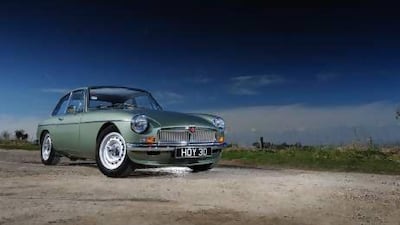Classic is cool these days, there's no denying that. Whether it's the Mad Men effect or simply that we're getting fed up with everything looking the same and doing the same thing, who knows, but it's definitely hip to be different by possessing and using something that's defiantly old. The problem with old cars, however, is that they don't usually work very well.
A few weeks ago in these pages, we considered the Eagle Speedster - a modern interpretation of the timeless Jaguar E-Type - that is built to modern-day standards that far surpass any of the cars that rolled out of Browns Lane when they were new. But it turns out that there's another, more humble British classic that's being reworked with the "better than new" treatment nowadays: the MGB GT.
The MGB celebrated its 50th birthday in 2012 - a milestone that went by largely unnoticed outside the almost fetishistic world of MG enthusiasts - but one that's been celebrated in unprecedented style by a UK company called Frontline Developments.
Fed up with the constant unreliability of his MG Spridget's gearbox, engineer Tim Fenna developed and built a five-speed conversion. As is the way in these owner communities, news rapidly spread and Fenna faced unprecedented demand from similarly frustrated owners - and a business was born.
That was back in 1992 and the company has expanded well beyond fixing recalcitrant Spridget transmissions. Frontline now completely re-engineers MG's classic models and, to commemorate the B's half century, embarked on a project called LE50. Ed Braclik is Frontline's project manager and, as he explained, it's like no other MGB.
"The only parts of the LE50 that are original are the body panels," he told us. "We use the [fastback] GT structure because it's stiffer than the roadster, and everything in it is new. The engine and gearbox are from Mazda and we've tuned it to go and sound like a classic sports car. In fact, the majority of our customers are coming to us for something different to their BMW M3s and Porsche Caymans."
That 220hp engine helps propel the LE50 to speeds previously unheard of for the MGB, hitting 260kph, and 100kph from rest in just five seconds - figures normally associated with brand-new sports cars from Germany. When it came to re-designing the interior of the LE50, said Braclik, quality, style and practicality were the key drivers. "Created using only the finest materials, we have retained the original charm and elegance of the MG but taken it into a category more familiar with Aston Martin and Bentley owners."
Manufactured as a two-seater GT car, with a two-plus-two version available as an option, the LE50 is not, Braclik insisted, just a weekend sports car. "We designed it to be used every day, as a real alternative to a BMW or Porsche," he said.
Modern refinements, such as Alcantara head lining, dashboard and crash rail are standard fit, with Alcantara or high quality leather covering the seats, doors and interior panels. Wilton wool carpets cover the floors, with a mass of billet alloy switchgear providing some eye candy on the dash. And there's no push button radio in the LE50 - instead, there's an excellent Harmon Kardon sound system and, for those using the car through the seasons, heated seats, windscreens and air conditioning form part of the options list.
Smiths were commissioned to resurrected drawings of the original 1962 gauges and recreate them to match the new engine and running gear. The original glint of orange at 5,000 rpm is now clear all the way to 7,800 before warning to change gear, with the speedometer now climbing all the way to 275kph. It might look the same as an MGB GT but there's nothing familiar about what's underneath that lovely bodywork.
They take up to 750 man-hours to build each bespoke LE50 (Limited Edition 50), which is the reason behind the car's average price of around £80,000 (Dh470,000) and up. But despite the price, it is a sorely tempting proposition to drivers who want the best of both worlds - timeless looks and cutting-edge craftsmanship. But could one be viewed as a viable mode of transport for the Middle East? Braclik insists it's perfectly feasible, adding: "One of our customers, whose car is currently being built, is actually based in Abu Dhabi." Let's hope, for his sake, that the air conditioning is as Japanese as the engine.

